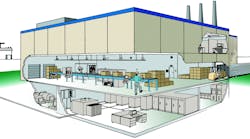(For a copy of this article in PDF format, which displays full text and figures, click here. Requires Adobe Acrobat Reader, free download.)
Since Electrical Wholesaling first published what has become known as the “Electrical Pyramid” in January 1994, this analysis of the electrical wholesaling industry's channels of distribution has become one of the magazine's most requested feature articles. University students in industrial distribution curriculums, consultants, manufacturers new to the industry and senior marketing and management executives at established electrical companies all use the Electrical Pyramid to gain insight into what makes this business tick.
Companies new to the electrical wholesaling industry use this resource to select a channel or mix of channels to sell electrical products. For electrical manufacturers analyzing their companies' — or competitors' — distribution strategies, the Electrical Pyramid helps them compare and contrast the various channels of distribution. From what readers have told EW's editors, it's not uncommon for the Electrical Pyramid to be to used as a discussion point at board of directors' meetings.
With all the changes that have occurred in the electrical marketplace over the last few years, it was time to update this industry resource so that it provides a snapshot of the channels of distribution in the electrical business as they stand today. This article will offer a brief overview of the various levels of distribution; Part two will continue this discussion and provide a resource list for those readers looking for additional information on any of the specific channels.
The industry as a wholeThe size of the electrical wholesaling industry surprises many people. Electrical Wholesaling's 2000 Regional Factbook forecasts total industry sales through electrical distributors for 2001 at $84.36 billion, a 7 percent increase over the $78.75 billion 2000 product sales forecast.
Another interesting fact about the industry's size is the number of electrical distributors. Using the generally agreed upon definition of an “electrical distributor” as any company with 50 percent of its sales in electrical products, more than 4,000 electrical distributors exist in the United States. These companies operate about 6,000 branch locations, according to 2001-2002 Directory of Electrical Wholesale Distributors.
While these numbers by themselves are impressive, the electrical marketplace is actually much larger because many companies other than electrical distributors sell electrical supplies, as you will see in the Electrical Pyramid. For instance, W.W. Grainger Inc., Lake Forest Ill.; Home Depot Inc., Atlanta; and Lowe's, Wilkesboro, N.C., each sell more than $1 billion in electrical supplies annually, yet none of them fit the traditional definition of an electrical distributor. Electrical manufacturers also use more than 20 other channels to sell electrical supplies other than the traditional full-line electrical distributor, as you will see on the next page. It's impossible to come up with an exact dollar amount of electrical products sold through many of these individual channels; it's more important to note that many more paths exist to the market than most people probably realize.
That being said, the sales of electrical products through full-line electrical distributors still dwarf the sales through any other alternate channel, as electrical distributors of electrical supplies sell well over 60 percent of all electrical products.
Market channelsThe common thread linking these alternate channels can be summed up in one word: specialization. These alternate channels all specialize in either a product area, like lamps, datacom products, industrial controls, wire and cable or motors; customer segments, like home centers; or marketing techniques, like catalog houses, or, in a different sense, buying/marketing groups. The Electrical Pyramid illustrates the profusion of different electrical product marketing channels. Although dozens of individual channels exist today, the electrical marketing industry can be sorted into several major channels or layers of distribution:
-
Full-line distributors of electrical supplies;
-
Hybrid distributors;
-
Product specialists;
-
Service businesses that get into the sale of electrical products as an adjunct to the function they perform, such as energy service or demand-side management (DSM) companies, motor repair shops and lighting maintenance companies;
-
Retail or consumer-based channels, such as home centers, super stores, catalog sellers and retail lighting showrooms;
-
Distributors from other wholesale trades, like plumbing or industrial supplies that deal in electrical products as well;
-
Manufacturer-based channels, such as manufacturers selling direct and buy/sell reps;
-
Other channels such as the Web-based companies, the gray market and manufacturers selling direct.
Within each of these layers, companies may mix and match approaches. A traditional electrical wholesaler may run a catalog business or have a factory automation division. A small lighting manufacturer may operate as a distributor of lighting products as well. A number of smaller alternate channels exist, too, that really don't fall under any one category.
Each of these channels has a history all its own, a different take on the manufacturer-rep-distributor-customer equation, and its own competitive problems with other channels. Now let's take a more in-depth look at each of the various channels to market.
DISTRIBUTORS OF ELECTRICAL SUPPLIESUnlike some other distribution-based industries, the electrical wholesaling business is still relatively fragmented. The 250 largest electrical distributors account for about 50 percent of the industry's sales. Most industry observers agree that this percentage will increase dramatically over the next few years, but it will still take years until the electrical industry consolidates as much as the pharmaceutical or electronics industries, where three or four distributors control the vast majority of sales.
The most significant industry associations for distributors of electrical supplies are the National Association of Electrical Distributors (NAED), St. Louis, and five buying/marketing groups: the three largest — Affiliated Distributors Inc., King of Prussia, Pa.; the IMARK Group, Oxon Hill, Md.; and Equity Electrical Associates Inc., East Walpole, Mass.; and two smaller groups — the United Purchasing Association (UPA), Sanford Fla., and the Electrical Distributors Network (EDN), Concord, Ohio. At least 600 electrical distributors belong to these five buying/marketing groups.
Two other important trade associations in the electrical wholesaling industry are the National Electrical Manufacturers Representatives Association (NEMRA), Tarrytown, N.Y., and the National Electrical Manufacturers Association (NEMA), Rosslyn, Va. NEMRA offers independent manufacturers' reps and their vendors a forum to discuss joint marketing and sales goals, as well as resources that help reps run their businesses more profitably, while NEMA's members focus on developing technical standards for products, as well as standards for electronic communication.
Distributors of electrical supplies can be divided into different sub-channels, or types of companies:
National chains. There are four national chains — Graybar Electric Co., St. Louis, Mo.; WESCO Inc., Pittsburgh, Pa.; Consolidated Electrical Distributors, (CED) Inc., Westlake Village, Calif.; and GE Supply Inc., Shelton, Conn. According to the most recent industry figures available at press time, these companies account for about 16 percent of total industry sales. In recent years, these companies have all been actively acquiring new locations and starting up new branches to strengthen their distribution networks.
European giants building national networks in the United States. Over the last three years, Rexel SA, Paris; Sonepar SA, Paris; and Hagemeyer NV, Naarden, Netherlands, or their U.S. subsidiaries have purchased some of the largest independent electrical distributors (many in EW's Top 250 listing) in North America. These companies include Allied Electric Supply Co., Pittsburgh; Anesco, Kingston, Pa.; Blazer Electric Supply Co., Colorado Springs, Colo.; The Branch Group, Upper Marlboro, Md; Brook Electrical Distribution Co., Chicago; Cameron and Barkley, Charleston, S.C.; Capital Lighting and Supply Inc., Alexandria, Va.; Colotex Electric Supply, Loveland, Colo.; Commerce Electric Supply Inc., Linthicum, Heights, Md.; Cooper Electric Supply, Tinton Falls, N.J.; Dixie Electric Supply Corp., Richmond, Va.; Electrical Suppliers Inc., Norfolk, Va.; Lee Electric Co., Baltimore; Maverick Electric Supply Inc., Dallas; McJunkin Corp.; Charleston, W. Va.; Ryall Electric Supply Co., Denver.; SPT Electrical Group, Princeton, N.J.; Tristate Electrical and Electronics Co. Inc., Hagerstown, Md.; United Electric Supply Co., St. Louis; Viking Electric Supply Inc., St. Paul, Minn.; and Westburne Inc., St. Laurent, Que. These acquirers have also purchased several smaller firms as well.
While these companies aren't really a distribution channel in and of themselves, because of the “blue-chip” companies that they have acquired, the clout that they have in today's electrical wholesaling industry cannot be underestimated.
Approximately 600 other NAED firms. With the 655 main house locations and 3,565 branches reported on its Web site, NAED is the largest of the industry's distributor associations. Its members tend to be full-line electrical distributors.
Over 3,000 other distributors of electrical supplies. These companies are generally much smaller than NAED firms or any of the other full-line distributors mentioned here.
HYBRID DISTRIBUTORSFor the purposes of this analysis, hybrid distributors are large distribution companies where electrical products are part of a much broader portfolio, or larger firms with a truly unique blend of products, installation capabilities or service offerings.
Anixter Inc., Skokie, Ill.; Fastenal Inc., Winona, Minn., and W.W. Grainger Inc., Lake Forest, Ill., are the three largest hybrid distributors selling electrical supplies into this market.
Anixter Brothers Inc.Because of its size, with total sales of $3.5 billion and 5,000 employees in 180 cities, and its position in the fast-growing datacom market, Anixter can be considered a market channel unto itself. Founded in 1957, Anixter continues to break new ground in the datacom market. Most industry observers agree that this company and Graybar are the only two distributors in the datacom market with a national presence. All of the other distributors tend to be more regional in nature.
Fastenal Inc.Although electrical products aren't the main interest of the fasteners giant, over the past two years, the company has built a sizeable electrical business and is actively adding electrical products to the 150,000 stock-keeping units (SKUs) that it stocks in its 850 locations. Threaded fasteners such as screws, nuts, and bolts account for about half of sales and the 150,000 items in its mega catalog. The company had $745.7 million in total sales last year.
W.W. Grainger Inc.No one else in the electrical marketing industry does business quite like Grainger. From the satellite dishes on top of its branch locations that beam orders back to its Illinois headquarters, to its sophisticated order-handling and next-day-delivery shipping systems, Grainger has embraced some of the cutting-edge technologies of our time and put them to work in the marketplace. The company estimates that 70 percent of all U.S. businesses are within 20 minutes of a Grainger branch.
PRODUCT SPECIALISTSOver a dozen distinct types of product specialists exist. They concentrate on many different products, including lighting fixtures, motors, automation products, lamps, industrial controls, wire and cable, energy-conservation products, utility products, datacom products, premises-wiring equipment, fuses and electrical insulation materials. Some of these distributors are strictly distribution firms, and do not handle any design, installation or repair capabilities, while others, such as automation specialists, energy-service companies and motor repair shops offer these other services along with distributing products.
A complete analysis of each of the product specialties is beyond the scope of this article. If you are looking for an overview of the role of these specialists in the electrical market, you may want to purchase a copy of The Electrical Marketer's Survival Guide, by calling (913) 967-1946. While this article highlights the biggest changes in the channels to market, the book covers the various distribution channels in much more detail.
RETAIL CHANNELSAfter full-line electrical distributors, the next most visible way for electrical products to get to market is the retail channel. Home centers, hardware stores and residential lighting specialists account for close to $10 billion in total sales of electrical products. Department stores and other retail shops sell some lighting products, too.
The Home Depot Inc.Because of its size and stature as a channel for electrical supplies, like Anixter and Grainger, Home Depot is a distinct marketing channel. Although most electrical distributors seem to have figured out how to compete with Home Depot and the other retail competitors, this company still has a huge impact on the electrical market.
An estimated 6.6 percent of the company's $45.74 billion in 2000 sales are in electrical products, which would easily rank it among the 10 largest distributors on EW's top 250 list. Now that Home Depot has painted most of the major metropolitan markets in the United States with its familiar orange-and-white colors, the company is in aggressive international expansion mode, and now has more than 1,000 locations worldwide.
While it's true that a healthy percentage of its sales come from residential lighting fixtures and ceiling fans — areas that don't concern all of the companies in other electrical marketing channels — that's still a huge pile of product.
Lowe's Co.The Wilkerson, N.C.-based Lowe's is a strong and still-growing player, with over 600 stores and $18.8 billion in sales last year. While Home Depot has reached the saturation point in many markets, Lowe's still has plenty of room to grow. The company's electrical sales probably top $1 billion, which puts it in exclusive company as one of the largest sources of electrical products in the United States.
Hardware storesElectrical products are one of the core product groups for hardware stores, and most of these retail outlets will have at least one or two aisles of the most commonly needed electrical supplies. In fact, electrical products account for 9 percent of the average hardware store's total sales, according to Do-It-Yourself Retailing magazine. Hardware stores don't target electrical contractors and other professional contractors as much as home centers, although it's quite common to find some tradespeople in hardware stores picking up a few items they forgot or that they need for weekend jobs when they are moonlighting.
Residential lighting specialistsAs much as full-line electrical distributors complain about Home Depot and other home centers, residential lighting specialists have an even bigger battle on their hands with home centers. Walk into virtually any home center and at least half — if not more — of the total square footage of floor space devoted to electrical products is soaked up by residential lighting fixtures. What hurts showrooms even more is that hanging on the walls and ceilings of home centers are some of the premier lines of lighting fixtures and ceiling fans.
Another seemingly perpetual challenge in this market is the problem with knock-offs, where some industry leader comes out with an innovative lighting fixture design, only to be soon followed by an imitation from offshore.
Savvy showrooms compete by concentrating on niche products, such as chandeliers; offering enhanced lighting packages to the new construction market; and working harder than ever to target the high-end residential market, where home centers are still weak.
To be continued.








